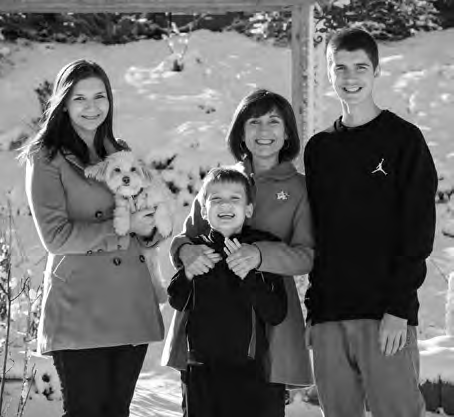100 Perks of Having Cancer: Plus 100 Health Tips for Surviving It (100 page)
Read 100 Perks of Having Cancer: Plus 100 Health Tips for Surviving It Online
Authors: Florence Strang
Tags: #Health; Fitness & Dieting, #Diseases & Physical Ailments, #Internal Medicine, #Oncology, #Cancer, #Medicine & Health Sciences, #Clinical, #Medical Books, #Alternative Medicine, #Medicine

ever, as the quality of iron ore is subpar and can give your
cookware “hot spots” instead of an even, uniform heat.
What’s wrong with Teflon, calphalon, and copper? To begin with, the
U.S. government has mandated that all Teflon manufacturers change the
chemical composition of Teflon by the year 2015. Until then, the nonstick
Perk #99: Cancer Introduced Me to a New Way to Get a Buzz
425
pots and pans will be emitting toxic gasses when heated, putting us at risk
for cancer and causing flulike symptoms and possible birth defects.
Calphalon is a nonstick chemical made with aluminum. The research
is not conclusive, but there are indications that cooking in aluminum can
increase risks of Alzheimer’s disease and multiple sclerosis.
Copper is fine healthwise, but it’s crazy expensive. Who wants to spend
$90 on an eight-inch fry pan?
Cast Iron Makes Sense in So Many Ways
●
Cast iron is very affordable. Not only can you get complete sets of cook-
ware for about $50, but also if you look, you are sure to find cast-iron
pots and pans at yard sales and thrift stores for just a few bucks. No matter
what the conditions, they can always be reseasoned (the term for getting
the surface back to being “cookable”).
●
Cast iron will never peel, flake, chip, or warp . . . ever!
●
The best cast iron is old cast iron. You can use the same pan for hundreds
of years and beyond. Pass it down to your kids, grandkids, and great-
grandkids! The more you use it, the better it gets.
●
Cast iron retains heat better than other pans so your food stays hot even
after the stove is off. The heat is distributed more evenly, making it the
favorite cookware for shallow or deep-frying and the preferred cookware
of master chefs.
●
Cooking in cast iron increases the iron content in your food. Iron is an
important mineral for overall health.
●
A well-seasoned cast-iron pan far surpasses any chemical nonstick surface
for supreme “nonstickiness.” Food slides out without a spatula.
●
You can move food from stove top to oven without concern.
●
If you don’t like black cookware, you can choose enameled cookware in
a variety of colors. The enameled version has all the same properties as
the black cast iron, but it can match your kitchen. (The enamel can chip,
but that’s the only difference.)
426
100 Perks of Having Cancer
●
You can use cast iron outdoors over an open fire and indoors on electric
or gas heat.
●
Cast-iron pans make excellent weapons. One hit over the head and
your assailant is stopped in his tracks (or has a face in the shape of a
frying pan).
●
Cast iron comes in a multitude of shapes and sizes. You can get muffin
and cornbread pans in fun shapes like cactus or ears of corn.
Cast-Iron Care Is Easy
●
Never use soap! Wash with hot water and a stiff nylon brush. If food is
stuck, add some water and place it back on the stove. The heat will boil
the stuck residue off. Never put cast iron in the dishwasher.
●
Towel-dry immediately. Do not air dry, as water is your pan’s enemy.
●
Never place a hot pan into cold water as it could cause thermal cracking.
●
Use nonmetal utensils to avoid scratching the “seasoned” surface.
●
Apply a light coating of oil to the pan while it’s still a bit warm before
putting it away.
So Why Doesn’t It Ever Rust?
The secret is in the seasoning. Oil must be baked in and continually
applied to make the surface water resistant. If your pan is not seasoned
properly or not cared for, it can rust. But the great thing is, you can always
reseason to restore it back to its original cooking condition. You literally
cannot destroy it!
Most pans you get new are “preseasoned,” which means they are ready
for the stove or oven. But if you’ve found one at a garage sale or left one
sitting in water, it can cause the pan to get dull, light gray areas on the sur-
face. When this happens, it needs reseasoning. Here’s how:
●
Scour off rust or dull areas with a fine steel wool.
Perk #99: Cancer Introduced Me to a New Way to Get a Buzz
427
●
Wash in hot soapy water (yes, this time, you can use soap) using a stiff
brush.
●
Apply a thin even coating of melted cooking oil of your choice inside
and out.
●
Place foil or cooking sheet on the bottom rack of the oven to catch any
oil drips.
●
Set oven to 350 to 400°F.
●
Place cookware upside down on the top rack of the oven.
●
Bake for 1 hour. When done, turn the oven off, but leave the pan in.
●
When cooled, store in a dry place and use as if new.
Another great reason to use cast iron is your goal to get stronger arms.
Since cast iron is heavy, the more cooking you do, the stronger you’ll get.
Cook more . . . get strong and healthy. Watch for my DVD:
The Frying Pan
Workout
. (I’m kidding, of course.)
I love my cast-iron pans, and I now have a set that allows me
Cooking with
the pleasure of using only cast iron for everything I cook. I have
cast iron is not
two from my mom and my mother-in-law, and then I bought a
only healthy;
set from Lodge. Founded by Joseph Lodge, this family-owned
it’s smart and
company has been making cast-iron cookware since 1896 and is
economical, too.
the number-one company making cast iron in the United States
today. You can visit them at www.lodgemfg.com to start or add
to your cookware collection. They also have great recipes and cookware tips.
You might even become such a fan that you will want to join the Inter-
national Dutch Oven Society. Check out their website (www.idos.com) for
tips and recipes. “Come an’ git it” indeed.




Perk #100
I Am a Survivor!
W
hen I began my blog in Octo-
ber 2011, I described myself
as:
“A forty-four-year-old breast can-
cer
‘
warrior’ . . . meaning that I am
actively battling the disease, but not
yet far enough along to call myself a
‘
survivor.’”
I believed that the term
survivor
was reserved for those who
were declared cancer-free and that
I had not yet earned myself that
title. I figured that once my treat-
ments were done, and there was
no evidence of disease left in my
body, only then could I call myself
a survivor.
On March 30, I drove myself to the hospital for my last radiation treat-
ment. As I walked back to my car afterward I thought,
So, this is it. It’s done.
Can I now finally call myself a survivor?
There were no banners or fireworks
to mark the occasion. No news camera crews were rushing at me asking,
“So, Florence, how does it feel to be a survivor?” In fact, the staff at the Can-
cer Center hadn’t even bothered to get me a cake. It was then that I made
an important realization.
Being a survivor is not about killing cancer cells. For all I know, there
could still be tiny, living cancer cells lurking in my body, ready to take up
residence elsewhere. What if I wait for the much anticipated five-year mark?
Then do I call myself a survivor? Well, I know of cases where cancer returned
fifteen or even twenty years after the initial diagnosis. So can one really ever
say that they SURVIVED cancer? I guess it is only if we die of something
else that we truly can say we survived cancer.
I 428 J

Perk #100: I Am a Survivor!
429
That was my
Aha
moment! The moment I realized that being a survivor
is not about what cancer does to your body, but about what it does to your
spirit, and that I had been a survivor all along. Cancer did not diminish my
faith in God or weaken my relationships with my loved ones. It did not steal
my hopes and dreams. It did not make me doubt my belief in myself and
my ability to face any challenge. Cancer weakened my body, but my spirit
has never been stronger.
No matter what your diagnosis, you too can be a survivor, because being
a survivor is not about outliving cancer. It is about attitude. You did not
